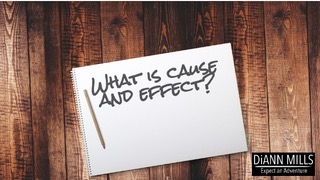
Cause and effect work together to build scene after scene leading to the climax and resolution.
Bestselling stories explode from powerful emotions that push a character into authentic cause and effect. The process is the backbone of fiction. A character is deeply motivated and commits skills, time, energy, and knowledge to pursue something, be it tangible or intangible. The something is valued, meaning sacrifices are expected. The reader will feel cheated if the character is not willing to give up that which is treasured.

Cause is the physical action the character uses to obtain a goal or solve a problem. Cause begins as a desire, which is emotional. The urge grows and refuses to abandon the character, increasing its worth. The cause now has an emotional attachment. The character is motivated into action, and nothing can get in his or her way. The character devises a plan either simple or detailed, according to the character’s personality, backstory, inherited traits, and life experiences.
Effect is the internal reaction the character feels as a result of the external action. An emotion pairs with a favorable or unfavorable outcome of the action. The effect is triggered by a unique character who views life according to the same criteria as cause: personality, backstory, inherited traits, and life experiences. These internal reactions vary from scene to scene, and more than one emotion can be involved.
Cause and effect work together to build scene after scene leading to the climax and resolution. Each scene’s goal depends on the previous outcome, whether the objective is gained or the stakes increase. The character learns new information and works steadily toward the main goal. Each new cause can’t occur without the previous one(s), and the effect is the emotive fuel pushing the character forward.
Five essential components accompany cause and effect:
- Unpredictable
- Purposeful
- Logical
- Authentic/In Character
- Not always the same
Believable and unexpected is the writer’s mantra. Using the easy effect spoils the reader’s adventure. Look for ways to connect the action or behavior with the character’s inner workings that are unforeseen but make sense with the character’s traits. Use the literary technique, “what’s the worst thing that could happen to the character in this scene” and take it to the third or fourth level. The effort keeps the reader immersed in the story.
Example:
Cause: A man meets a woman and is wowed by her beauty, brains, and wit.
Effect: He can’t stop thinking about her. He hears her laughter in his head, smells her perfume, and longs for her touch.
Cause: A woman purposely meets a man whom she has set up for blackmail by looking her best, knowing his interests, and laughing at his jokes.
Effect: She’s pleased, satisfied that her plan is working. She will get even for his breaking up with her sister and sinking her into medically diagnosed severe depression. The sister is hospitalized in a mental facility.
Cause: The man asks the woman for a dinner date. She accepts.
Effect: He is thrilled. He’s never felt like this about a woman before.
Cause: The woman moves forward at dinner to lure the man into believing she cares about him.
Effect: The woman is frustrated when the man refuses her advances. He says it’s too soon. They have something special together, and he doesn’t want to move too fast and ruin the budding relationship.
Cause: The man chooses to tell the woman about his last dating experience. She fell for him hard, but he didn’t have the same feelings.
Effect: He sees anger on the woman’s face and believes his refusing her advances has upset her.
Cause: The woman explodes and tells him that woman he cast aside was her sister.
Effect: The woman knows her sister didn’t lie, and the man is feeding her the same lines that he told her sister.
Cause: The man tells her he might have left out a few things. He apologizes for her sister’s reaction. He begs for a chance with this woman, but she leaves the table.
Effect: He tried to add another conquest to his list, but his game ended in a stalemate.
Cause and effect raise the stakes throughout the story. Whatever matters to the character can’t be easily obtained. The process takes work, physically and internally. The result is a character who shows themself through authentic action and emotion that burst onto the page and grip the reader until the last line.
DiAnn Mills is a bestselling author who believes her readers should expect an adventure. She is a storyteller and creates action-packed, suspense-filled novels to thrill readers. Her titles have appeared on the CBA and ECPA bestseller lists; won two Christy Awards; and been finalists for the RITA, Daphne Du Maurier, Inspirational Readers’ Choice, and Carol award contests. DiAnn is a founding board member of the American Christian Fiction Writers, a member of Advanced Writers and Speakers Association, Mystery Writers of America, and International Thriller Writers. DiAnn continues her passion for helping other writers be successful. She speaks to various groups and teaches writing workshops around the country. Connect with DiAnn on her various social media platforms here: www.diannmills.com
